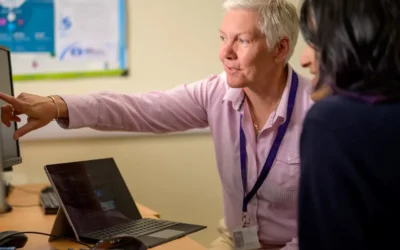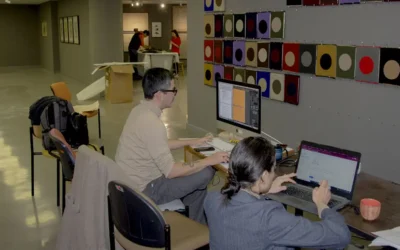Relevance & The Museum’s Role in Social Wellbeing

Rachael Cristine Woody
To those who love and work in institutions that promote art, history, and culture, the relevance of those institutions seems quite obvious. So too, does the positive impact a museum and library can have on an individual. Yet, seemingly every year there’s a flurry of talks and articles that ask “Are Museums and Libraries Still Relevant?”
A Forbes article titled “Amazon Should Replace Local Libraries to Save Taxpayers Money” was published July 21, 2018 and deleted July 23 due to swift and significant backlash and fact correction. Written by Panos Mourdoukoutas, the main thrust of the economic professor’s argument was: libraries only provide physical books and Wi-Fi, he can buy his own books through Amazon and people can use free Wi-Fi at Starbucks, so libraries should close to save taxpayers money. Rebuttal tweets and articles sprang up to counter that libraries do so much more. While the facts and anecdotes were numerous, they can essentially be summed up to state that the library provides social services to the community to help fill the gap where government and social service support ends. In effect, buoying the community’s social wellbeing.
As recent as 2013, the then president of the American Alliance of Museums (AAM) Ford Bell was on CNN to answer the question Are Museums Still relevant? In the article, Bell makes the case that museums are more than just the “collectors and exhibitors of our collective art and heritage,” and further reasons that museums are committed to public service and help to fill the “social service gaps created by the recent economic downturn.” Bell asserts the AAM’s studies have shown that since the Great Recession in 2008, 66% of museums have reported feeling financial stress as it relates to their standard operation. In a time where government support is declining (from all levels of government), museums services to support community social wellbeing are increasing.
While it can be asserted that a museum’s benefit to the social wellbeing of a community can and should be enough, Bell makes a point to go on the record regarding the economic impact museums provide. Bell states, “They say that, for every $1 a municipality invests in cultural organizations, including museums, $7 are returned to the public coffers. That’s a return that would make Warren Buffett swoon.” The AAM and the federal Institute of Museum and Library Services (IMLS) offer further evidence with the estimate that there are 850,000,000 annual museum visits in the US. Bell compares that number to sports attendance stating, “that’s more than the attendance at all major league sporting events combined.”
In 2017, the Secretary of the Smithsonian, David Skorton wrote in an AAM article, “Why Museums and Libraries Are More Relevant Than Ever”:
All across this country, in cities and in rural areas, cultural institutions are helping to strengthen our communities through the arts, history, culture and science. Like the Smithsonian, these organizations are working to foster meaningful dialogue about what’s important to their communities and to the country. – Smithsonian Secretary, David Skorton, February 27, 2017
We as museum professionals know this to be true, but it’s hard to craft a persuasive argument due to the lack of statistics or qualitative evidence in this area. But it won’t be for much longer. On August 29, 2018, IMLS announced a national study “Understanding the Social Wellbeing Impacts of the Nation’s Libraries and Museums”. The study is intended to measure the museum and library’s critical role within communities, especially as it pertains to the influence over and contribution to the social wellbeing of community members.
According to IMLS:
The goal of the year-long project is to gain a better understanding on a national level of the conditions under which museums and libraries contribute to quality of life and wellbeing in the communities they serve. The new study will focus on these institutions’ essential roles within a community to help them demonstrate the success and impact of their programs and services.
With this study IMLS is building upon its 2016 study Strengthening Networks, Sparking Change: Museums and Libraries as Community Catalysts. While economic benefits are persuasive when it comes to advocating for municipal support, this new study will be focused on identifying and quantifying social wellbeing outputs, and “assess the relative wellness of individuals, communities, and nations” as it relates to their engagement with museums and libraries. The study will be conducted at the county level and will quantify the following 10 dimensions: standard of living, economic diversity, ethnic diversity, health, school effectiveness, housing quality, political connection, the presence of cultural institutions and nonprofit organizations in the community, the environment, and personal safety.

Rachael Cristine Woody
Similar Posts
How to Incorporate Interns in Museum CMS Projects: Data Cleanup and Refinement
A museum expert details how interns can be successfully included in museum CMS projects at the data cleanup and refinement stage.
How to Incorporate Interns in Museum CMS Projects: Data Creation
A museum expert details how interns can be successfully included in museum CMS projects at the data creation stage.
How to Incorporate Interns in Museum CMS Projects: Data Capture
A museum expert highlights how interns can be included in museum CMS projects at the data capture stage
How to Incorporate Interns in Museum CMS Projects
A museum expert highlights how interns can be included in museum CMS projects with three project ideas.
Hosting service
Enjoy all of the benefits of your Lucidea solution with secure, reliable, stress free hosting
Programs & incentives
No matter your size or budget, we’ve got you covered, today and tomorrow



